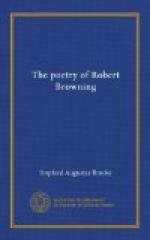This romantic passion which never dies even in our modern society, is embodied in the gipsy crone who, in rags and scarcely clinging to life, suddenly lifts into youth and queenliness, just as in a society, where romance seems old or dead, it springs into fresh and lovely life. This is the heart of the poem, and it is made to beat the more quickly by the wretched attempt of the duke and his mother to bring back the observances of the Middle Ages without their soul. Nor even then does Browning leave his motive. The huntsman has heard the gipsy’s song; he has seen the light on his mistress’ face as she rode away—the light which is not from sun or star—and the love of the romantic world is born in him. He will not leave his master; there his duty lies. “I must see this fellow his sad life through.” But then he will go over the mountains, after his lady, leaving the graves of his wife and children, into the unknown, to find her, or news of her, in the land of the wanderers. And if he never find her, if, after pleasant journeying, earth cannot give her to his eyes, he will still pursue his quest in a world where romance and formality are not married together.
So I shall find out some snug
corner,
Under a hedge, like Orson
the wood-knight,
Turn myself round and bid
the world Good Night;
And sleep a sound sleep till
the trumpet’s blowing
Wakes me (unless priests cheat
us laymen)
To a world where will be no
further throwing
Pearls before swine that can’t
value them. Amen.
* * * * *
CHAPTER XI
IMAGINATIVE REPRESENTATIONS
All poems might be called “imaginative representations.” But the class of poems in Browning’s work to which I give that name stands apart. It includes such poems as Cleon, Caliban on Setebos, Fra Lippo Lippi, the Epistle of Karshish, and they isolate themselves, not only in Browning’s poetry, but in English poetry. They have some resemblance in aim and method to the monologues of Tennyson, such as the Northern Farmer or Rizpah, but their aim is much wider than Tennyson’s, and their method far more elaborate and complex.
What do they represent? To answer this is to define within what limits I give them the name of “imaginative representations.” They are not only separate studies of individual men as they breathed and spoke; face, form, tricks of body recorded; intelligence, character, temper of mind, spiritual aspiration made clear—Tennyson did that; they are also studies of these individual men—Cleon, Karshish and the rest—as general types, representative images, of the age in which they lived; or of the school of art to which they belonged; or of the crisis in theology, religion, art, or the social movement which took place while the men they paint were alive, and which these men led, on formed, or followed. That is their main element, and it defines them.




